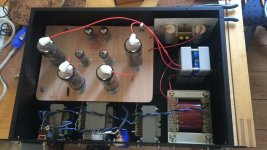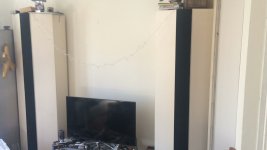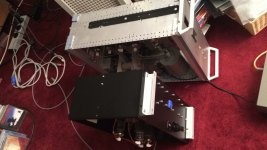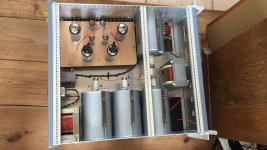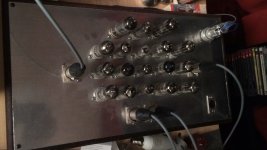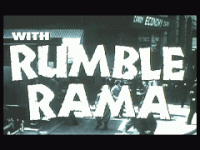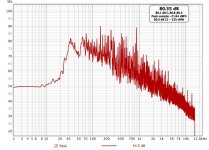Thanks to diyaudio I was introduced to Frank Verwaal's "The Design of Electrostatic Loudspeakers". http://home.kpn.nl/verwa255/esl/ESL_English_2011.pdf Awesome read. It reminded me that my rig violates the guidelines in the book to some extent. It also brought back all the things I had to unlearn in the quest for clean audio. The list is long. You must have lots of dispersion, electromagnetic speakers and ESLs don't "blend", SS amps are harsh sounding, digital signal processing will muck up the sound, diaphragm must be super thin, ESLs require your "head in a vise" a transformer exceeding a 50 to 1 ratio will resonate in the audio band, and no one makes good transformers like the old Mcintosh, it's a lost art, etc.
I wasn't afraid to experiment. After building a small full range ESL just out of scientific curiosity, the clarity of the sound knocked my socks off. I had dip for SPL, and burned up an amplifier before I got on to Sanders book, and built a stereo pair. There are times I like to really crank it up, feel the bass in my body. I decided full range was impractical, and went with a hybrid rig. I like a touch of harmonic distortion in the bass, and am happy with electromagnetic speakers in the low end, up to about 500 Hz.
Ended up with a 15 inch powered sub, 2 12 inch transmission line woofers, 3 5 inch drivers on each side in an open backed box, with 2 ESLs right and left of the boxes, 7 by 40 inches, 1/2 mil mylar, laboriously rubbed with graphite, .07" D/S spacing. Voltage driven through 1 to 100 turns ratio Sowter transformers, driven by a 300 watt QSC. Not counting the sub, it was a 3 way triamped rig with a Rane DSP handling the crossover and EQ. I did not have to do anything radical with the EQ. I had decenty flat response on the ESLs, 600 Hz to 20k. Position was equilateral triangle, 5 feet from the speakers.
Had over 100 people listen to it, blew them all away. Most would tell me next time I saw them that thanks to me, they now hated their stereo.
Imaging was astounding, the highend beamed like a laser which is fine with me. I have no desire to move when engaged in serious listening. My rig sounds better off axis than most high end electromagnetic systems do in the hot spot. And the lack of dispersion has 2 big advantages. Less channel crosstalk, lower diaphragm excursion since I'm not wasting energy on the rest of the room, and little or no acoustic treatment needed. I ran a 10k sine through the ESLs, measured THD + noise on a terrasonde and got .5%. If I could have eliminated the noise in the room from the amp fans and street noise leaking in, I'd bet it was closer to .3%.
It was the best rig ever, plenty of SPL. The problem I ran into is the acrylic spacers shrink over time, particularly if exposed to warm temperature, like hot summer. The aluminum stators were thin, and warped. I had other fish to fry for a good number of years and still have the spacer frames and new thicker steel stators. The frames have been stored for years, so I am hoping they have done their shrinking. Getting ready to restore the rig.
Can't wait.
I wasn't afraid to experiment. After building a small full range ESL just out of scientific curiosity, the clarity of the sound knocked my socks off. I had dip for SPL, and burned up an amplifier before I got on to Sanders book, and built a stereo pair. There are times I like to really crank it up, feel the bass in my body. I decided full range was impractical, and went with a hybrid rig. I like a touch of harmonic distortion in the bass, and am happy with electromagnetic speakers in the low end, up to about 500 Hz.
Ended up with a 15 inch powered sub, 2 12 inch transmission line woofers, 3 5 inch drivers on each side in an open backed box, with 2 ESLs right and left of the boxes, 7 by 40 inches, 1/2 mil mylar, laboriously rubbed with graphite, .07" D/S spacing. Voltage driven through 1 to 100 turns ratio Sowter transformers, driven by a 300 watt QSC. Not counting the sub, it was a 3 way triamped rig with a Rane DSP handling the crossover and EQ. I did not have to do anything radical with the EQ. I had decenty flat response on the ESLs, 600 Hz to 20k. Position was equilateral triangle, 5 feet from the speakers.
Had over 100 people listen to it, blew them all away. Most would tell me next time I saw them that thanks to me, they now hated their stereo.
Imaging was astounding, the highend beamed like a laser which is fine with me. I have no desire to move when engaged in serious listening. My rig sounds better off axis than most high end electromagnetic systems do in the hot spot. And the lack of dispersion has 2 big advantages. Less channel crosstalk, lower diaphragm excursion since I'm not wasting energy on the rest of the room, and little or no acoustic treatment needed. I ran a 10k sine through the ESLs, measured THD + noise on a terrasonde and got .5%. If I could have eliminated the noise in the room from the amp fans and street noise leaking in, I'd bet it was closer to .3%.
It was the best rig ever, plenty of SPL. The problem I ran into is the acrylic spacers shrink over time, particularly if exposed to warm temperature, like hot summer. The aluminum stators were thin, and warped. I had other fish to fry for a good number of years and still have the spacer frames and new thicker steel stators. The frames have been stored for years, so I am hoping they have done their shrinking. Getting ready to restore the rig.
Can't wait.
Sounds like a very successful project. In the whole known universe, not a lot of ESL systems without cone subs. But then there is the never-ending quest for the perfect formula for blending ESLs and cones. (I think there's no actual problem of harmonization since all kinds of sub enclosures seem to work OK, but some folks do ponder it.)
But in the intriguing long list in your first paragraph, could you please explain which are the bad old erroneous myths and which are true lessons from the Verwaal's book. I can't tell.
But in the intriguing long list in your first paragraph, could you please explain which are the bad old erroneous myths and which are true lessons from the Verwaal's book. I can't tell.
Last edited:
It's a very good book. I agree with most all of it. He said things I've been saying for years and he understands the physics and math better than I do. Most of the issues I had are not stated there. He does advocate current drive, and smaller panels to avoid being too "beamy", very thin diaphragms, Damping cloth, and concerns about standing waves.(I think there's no actual problem of harmonization since all kinds of sub enclosures seem to work OK, but some folks do ponder it.) please explain which are the bad old erroneous myths and which are true lessons from the Verwaal's book. I can't tell.
I don't think damping or standing waves are an issue, and voltage drive compensates for more durable, thicker diaphragms. Dispersion is more a matter of taste, and the application. I prefer digital parametric eq over chains of caps and resistors. The closer the amp is to the speaker the better. He does not indicate issues with hybrid systems.
If all the drivers in the system are producing low distortion, there is no problem with blending. If you want low distortion bass, servo speakers are available. I don't like them because they sound dry. Best bass I've heard was a 12 inch speaker in an 8 foot concrete tube. Just enough harmonic distortion to fatten it up without losing definition. The 15 inch sub was just for the very low stuff, under 80 Hz.
I think I might be able to...convince you, I mean.www.diyaudio.com/forums/planars-and-exotics/364330-isobaric-esl-alternative.html
So there's a couple of Linn 5150 subs to augment.
So there's a couple of Linn 5150 subs to augment.
Last edited:
Until now i have not yet heard any ESL hybrid system that could convince me. But i am always interested in new ideas. If you have the space then go for full range and direct drive amps.
That is something I would like to experience. My early experiments indicated that bass would be difficult. Trying to increase allowable excursion required such high voltages. It looked like it would be impractical without very large units. Falling impedance match to the air, cancellation from the back to the front and all that. I was looking at the size of my brother's string bass compared to a violin...
What I've read recently in the dyi rabbithole indicates I need to rethink my own conventional wisdom.
In my rig, the midrange only had to cover a bit over an octave, with 3 cones on each channel, they had an easy life, very low excursion. The ESLs were on the right and left of the midrange boxes handling 500 on up. I had a delay on them, to match the more distant 12 inch TL drivers. Everything hit the ear in phase.
I would like to hear a full range system that could match the SPL.
The issue is that you need lots of panels and place them against a wall or baffle to overcome low frequence rolloff. 1 amp can handle all 8 pannels so i use 2 power amps in total. The SPL is sufficiant for me as the system is very dynamic and revealing. The original amps could play a bit louder on 4 panels but sounded compressed.
You can test your bass performance with this track:
Andreas Vollenweider: Summer Rain, at about 3.5min (just after the flute solo)
The bass is not audible nor will it be felt but your ears will notice the airpressure (if your system is able to produce it).
You can test your bass performance with this track:
Andreas Vollenweider: Summer Rain, at about 3.5min (just after the flute solo)
The bass is not audible nor will it be felt but your ears will notice the airpressure (if your system is able to produce it).
Speaking of correct matching of sub to an ESL, in the sub forum, this planar sub just appeared:
PureLow LO Subwoofer | Hi-Fi+
36,000 euros each, I think. Maybe cheaper if you buy four for an Olive room set-up.
B.
PureLow LO Subwoofer | Hi-Fi+
36,000 euros each, I think. Maybe cheaper if you buy four for an Olive room set-up.
B.
You can test your bass performance with this track:
Andreas Vollenweider: Summer Rain, at about 3.5min (just after the flute solo)
The bass is not audible nor will it be felt but your ears will notice the airpressure (if your system is able to produce it).
The urge is strong to give bass panels a shot, but I really should get my hybrid rig up and running, Then I had to get sucked into the hill plasmatronics speakers. Now I'm ate up with the plasma.
Intrigued by what kind of signal would be inaudible, and not felt yet produces a feeling in the ears. I'll have to get the recording of course.
The Infraplanar units are very interesting indeed. Plasmatronics sounds interesting as well but never had the chance to audition those. I do have ionic tweeters but no "midrange" plasmas.
To be able to feel low frequency sound it must be of some volume. This is not the case here. It is very low volume (in comparison to the other instruments) and therefore can not be felt. Yet the pressure is strong enough to be noticed by ear. As the frequency is so low (i guess 16Hz) you can not hear it (should be able to measure it though).
To be able to feel low frequency sound it must be of some volume. This is not the case here. It is very low volume (in comparison to the other instruments) and therefore can not be felt. Yet the pressure is strong enough to be noticed by ear. As the frequency is so low (i guess 16Hz) you can not hear it (should be able to measure it though).
As the frequency is so low (i guess 16Hz) you can not hear it (should be able to measure it though).
Saw a video on speakers designed for subsonics. Upper limit was 20 Hz. The design was a fan with flat blades. At zero signal, they do nothing. The signal wiggles the blades back and forth, blowing and sucking air.
Some more tracks with heavy bass:
Nik Bärtsch's Ronin Live
Nik Bartsch's RONIN - jazz baltica 2011 fragm. 3 - YouTube
Michel Jonasz le temps passé
Le temps passe Michel Jonasz - YouTube
Ave Maria en Plein Air Tarja Turunen
Ave Maria - YouTube
Nik Bärtsch's Ronin Live
Nik Bartsch's RONIN - jazz baltica 2011 fragm. 3 - YouTube
Michel Jonasz le temps passé
Le temps passe Michel Jonasz - YouTube
Ave Maria en Plein Air Tarja Turunen
Ave Maria - YouTube
Nik Bärtsch's Ronin Live
Nik Bartsch's RONIN - jazz baltica 2011 fragm. 3 - YouTube
Yes, heavy bass but, as is often the case, listeners mistake loud 80 Hz for low bass. No kidding. Here's an electric RTA peak from the full 12 minute link.
So, not much below 30 Hz. Loud at 70-80 Hz. Unless an RTA shows substantially more voltage below 40 Hz compared to 80 Hz, you don't hear or feel the stuff below 40 Hz too strongly - it has to be really strong to be loud to you.
Perhaps Lampie519 has a better source for this music and can post their RTA to correct mine. Or maybe the other links are have lower bass.
B.
Nik Bartsch's RONIN - jazz baltica 2011 fragm. 3 - YouTube
Yes, heavy bass but, as is often the case, listeners mistake loud 80 Hz for low bass. No kidding. Here's an electric RTA peak from the full 12 minute link.
So, not much below 30 Hz. Loud at 70-80 Hz. Unless an RTA shows substantially more voltage below 40 Hz compared to 80 Hz, you don't hear or feel the stuff below 40 Hz too strongly - it has to be really strong to be loud to you.
Perhaps Lampie519 has a better source for this music and can post their RTA to correct mine. Or maybe the other links are have lower bass.
B.
Attachments
- Home
- Loudspeakers
- Planars & Exotics
- Defying Conventional Wisdom Worked. Hybrid ESL
